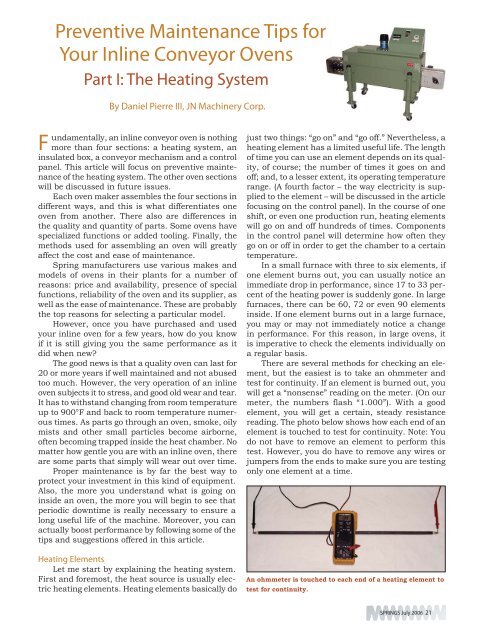Solid Height - Spring Manufacturers Institute
Solid Height - Spring Manufacturers Institute
Solid Height - Spring Manufacturers Institute
You also want an ePaper? Increase the reach of your titles
YUMPU automatically turns print PDFs into web optimized ePapers that Google loves.
Preventive Maintenance Tips for<br />
Your Inline Conveyor Ovens<br />
Part I: The Heating System<br />
By Daniel Pierre III, JN Machinery Corp.<br />
F<br />
undamentally, an inline conveyor oven is nothing<br />
more than four sections: a heating system, an<br />
insulated box, a conveyor mechanism and a control<br />
panel. This article will focus on preventive maintenance<br />
of the heating system. The other oven sections<br />
will be discussed in future issues.<br />
Each oven maker assembles the four sections in<br />
different ways, and this is what differentiates one<br />
oven from another. There also are differences in<br />
the quality and quantity of parts. Some ovens have<br />
specialized functions or added tooling. Finally, the<br />
methods used for assembling an oven will greatly<br />
affect the cost and ease of maintenance.<br />
<strong>Spring</strong> manufacturers use various makes and<br />
models of ovens in their plants for a number of<br />
reasons: price and availability, presence of special<br />
functions, reliability of the oven and its supplier, as<br />
well as the ease of maintenance. These are probably<br />
the top reasons for selecting a particular model.<br />
However, once you have purchased and used<br />
your inline oven for a few years, how do you know<br />
if it is still giving you the same performance as it<br />
did when new?<br />
The good news is that a quality oven can last for<br />
20 or more years if well maintained and not abused<br />
too much. However, the very operation of an inline<br />
oven subjects it to stress, and good old wear and tear.<br />
It has to withstand changing from room temperature<br />
up to 900°F and back to room temperature numerous<br />
times. As parts go through an oven, smoke, oily<br />
mists and other small particles become airborne,<br />
often becoming trapped inside the heat chamber. No<br />
matter how gentle you are with an inline oven, there<br />
are some parts that simply will wear out over time.<br />
Proper maintenance is by far the best way to<br />
protect your investment in this kind of equipment.<br />
Also, the more you understand what is going on<br />
inside an oven, the more you will begin to see that<br />
periodic downtime is really necessary to ensure a<br />
long useful life of the machine. Moreover, you can<br />
actually boost performance by following some of the<br />
tips and suggestions offered in this article.<br />
Heating Elements<br />
Let me start by explaining the heating system.<br />
First and foremost, the heat source is usually electric<br />
heating elements. Heating elements basically do<br />
just two things: “go on” and “go off.” Nevertheless, a<br />
heating element has a limited useful life. The length<br />
of time you can use an element depends on its quality,<br />
of course; the number of times it goes on and<br />
off; and, to a lesser extent, its operating temperature<br />
range. (A fourth factor – the way electricity is supplied<br />
to the element – will be discussed in the article<br />
focusing on the control panel). In the course of one<br />
shift, or even one production run, heating elements<br />
will go on and off hundreds of times. Components<br />
in the control panel will determine how often they<br />
go on or off in order to get the chamber to a certain<br />
temperature.<br />
In a small furnace with three to six elements, if<br />
one element burns out, you can usually notice an<br />
immediate drop in performance, since 17 to 33 percent<br />
of the heating power is suddenly gone. In large<br />
furnaces, there can be 60, 72 or even 90 elements<br />
inside. If one element burns out in a large furnace,<br />
you may or may not immediately notice a change<br />
in performance. For this reason, in large ovens, it<br />
is imperative to check the elements individually on<br />
a regular basis.<br />
There are several methods for checking an element,<br />
but the easiest is to take an ohmmeter and<br />
test for continuity. If an element is burned out, you<br />
will get a “nonsense” reading on the meter. (On our<br />
meter, the numbers flash “1.000”). With a good<br />
element, you will get a certain, steady resistance<br />
reading. The photo below shows how each end of an<br />
element is touched to test for continuity. Note: You<br />
do not have to remove an element to perform this<br />
test. However, you do have to remove any wires or<br />
jumpers from the ends to make sure you are testing<br />
only one element at a time.<br />
An ohmmeter is touched to each end of a heating element to<br />
test for continuity.<br />
SPRINGS July 2006 21





